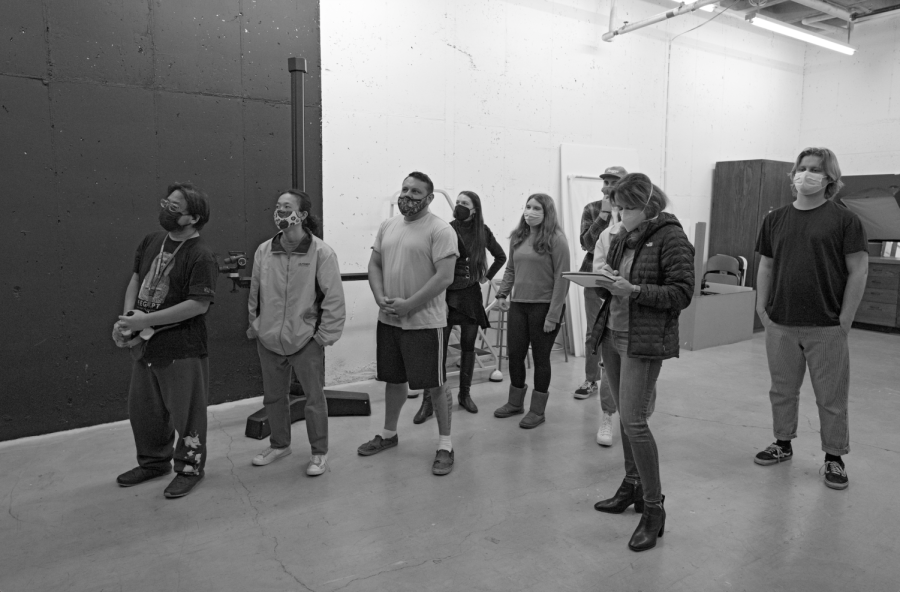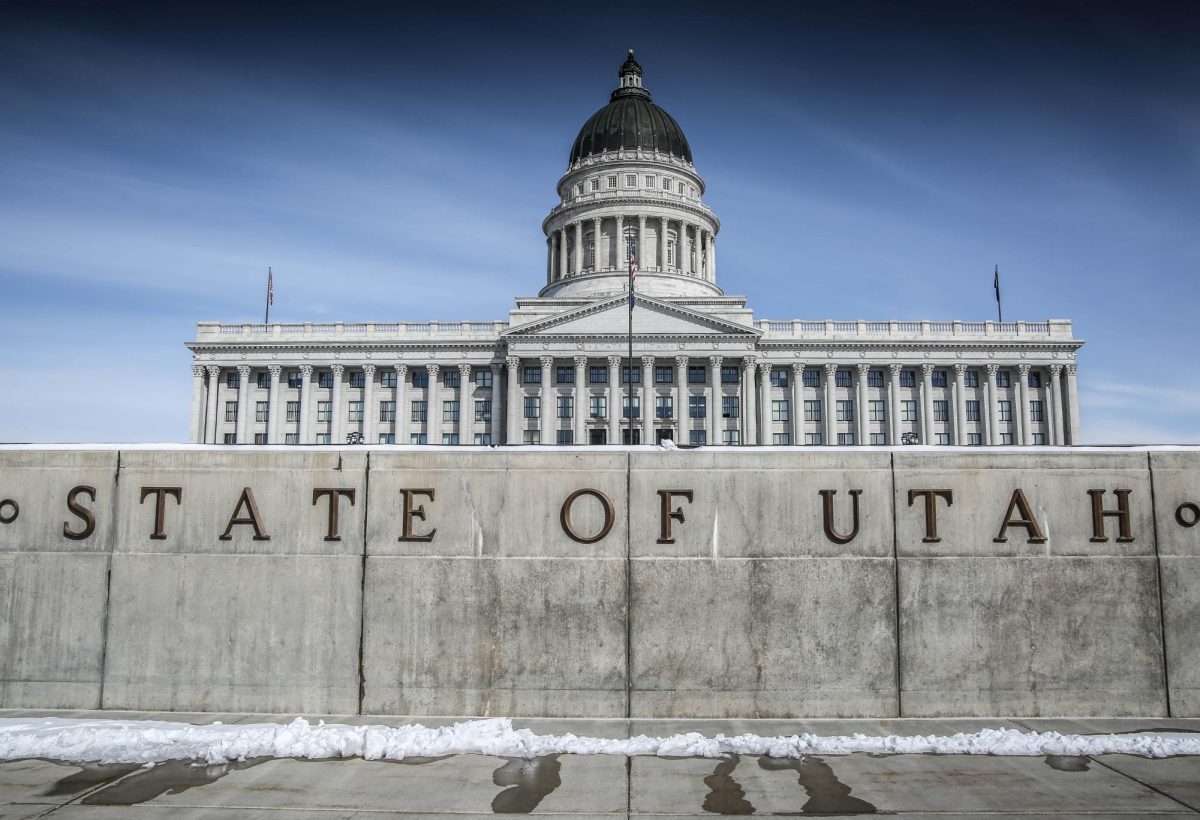U Students Respond to Another In-person Semester with New Protocols and Rising Cases
Students in Art 3755 working in the photo studio for the first time this semester. The images were taken in the photo studio located in the art building in Salt Lake City, Utah on Tuesday, Jan. 18, 2022 (Photo by Kevin Cody | The Daily Utah Chronicle)
January 22, 2022
Amid rising COVID-19 cases in Utah, University of Utah students return to in-person classes for the Spring 2022 semester.
On Saturday, Jan. 15, the Salt Lake Tribune reported Utah’s average daily COVID-19 case rates per 100,000 people to be the fourth highest in the country.
Anna Bell, a non-traditional student studying data science, said her classrooms are extremely full, with little social distancing, which she finds concerning.
“My biggest concern however, is for other students, especially students with disabilities, or people who are immunocompromised because I don’t think people are taking this seriously,” Bell said.
Bell decided to take action by creating a petition advocating for live-streaming options for students. As of Jan. 18, her petition has 525 signatures.
McKaiden Carruth, a junior studying neurobiology, said because the U is a “city within a city,” she is concerned about the impact students could have on the local community and hospitals.
“As an academic institution that is known for our medical programs, are we holding up to our obligation to be a higher and an above and beyond example, as we should be?” Carruth said.
Rebecca Walsh, associate director of communications at the U, wrote in an email interview that Utah state law requires the university to provide 75% of classes in-person during the Spring 2022 semester. This percentage is based on the number of in-person classes at the end of January 2020.
Walsh shared that instructional guidelines for the semester have empowered deans and department chairs to work with instructors who have had confirmed exposures in their classrooms. These guidelines allow a shift to virtual operations for a short time, based on guidance from the U Health contact tracing team.
Walsh added these classes must return to in-person after the quarantine and isolation period has passed.
Additionally, students may request temporary attendance adjustments through the Center for Disability & Access.
According to the Spring 2022 Instructional Guidelines, classes classified in the schedule as “in-person” must host live classes at the scheduled time in the assigned classroom. Faculty are provided discretion on providing options like live-streaming or class recordings.
Bell said she believes many professors haven’t received adequate interpretation of recent state legislation from administration on what accommodations can be provided to students. Bell said she emailed her professors to inform them they can provide live-streaming who were unaware of this option.
“Faculty don’t know what liberties they do have,” Bell said. “I think a lot of faculty care about student wellness, and they really want to offer online options, but they are not being educated by administration on a department and university level that they’re allowed to do that.”
On Jan. 7, the U released updated COVID-19 guidelines, including weekly testing and vaccination requirements. In eight locations on campus, students can pick up self-serve COVID-19 tests and drop them back off at any time.
Additionally, U students will need to receive COVID-19 booster shots or an exemption to remain in compliance with the COVID-19 vaccination policy.
With the Utah State Legislature overturning Salt Lake County’s mask order on Friday, masks are no longer required on the U’s campus. Still, Walsh stated the U will continue to encourage mask-wearing “during periods of high transmission when in buildings or in large groups of people outdoors.”
Utah state law currently prohibits higher education institutions from requiring face coverings on campus.
The U encourages students who are unvaccinated and exposed or test positive for COVID-19 to follow the 5-5-5 rule. This includes isolating for five days, getting tested five days after the initial result and masking around others for five days after that.
Carruth shared she appreciates the measures taken by the U, particularly the self-service testing, but feels adjustments are often necessary considering the current state of the pandemic.
“We do need to have more online options … for students to access a live class if they need to miss due to sickness or exposures, so they don’t need to get behind [and] professors don’t have to struggle with the juggle game of trying to rehash old information,” Carruth said.














John Hedberg • Jan 25, 2022 at 7:33 am
https://ourworldindata.org/explorers/coronavirus-data-explorer?zoomToSelection=true&time=2020-12-14..latest&facet=none&hideControls=true&Metric=Case+fatality+rate&Interval=7-day+rolling+average&Relative+to+Population=true&Color+by+test+positivity=false&country=~USA
This chart of the case fatality rate shows a 75-80% drop in severity since Christmas, when the Omicron wave swept in. Now is definitely the time to get your natural immunity, if you’re young and healthy (almost everyone under 30). For those with comorbidities, most long ago received their shots and boosters, so their severity (we hope) should be blunted.
I imagine that from here, the best strategy with Omicron is to continue to give boosters to the small percentage who are vulnerable, but allow everyone else to resume normal life, including the occasional corona-cold. Natural immunity ends pandemics. If you experience strong symptoms, you can go to the ER at Intermountain and they’ll give you monoclonal antibodies, but for 99.98% of people, stay home, snuggle up, open your favorite Ben & Jerry’s, and watch some good movies for a day. You’ll be much stronger after your sniffles (assuming you even have symptoms you’re aware of)!
Best, With Love,
J Hedberg
John Hedberg • Jan 24, 2022 at 1:15 pm
As of 19 January 2022, the CDC indicates that 5,241 Americans between 18 and 29 have died when COVID-19 was involved, which doesn’t mean they died of COVID-19, just that COVID-19 was associated. (https://www.cdc.gov/nchs/nvss/vsrr/covid_weekly/index.htm#SexAndAge)
This covers 24 months, and it accounts for about 4% of total deaths for this (collegiate) age group. According to the CDC, you’re more likely to die by accident, murder, or suicide than by COVID-19, so lighten up! Omicron is about as severe as a bad head cold, assuming you even detect your symptoms, so for 99.99% of college students, getting Omicron means developing lasting antibodies while staying home for a day eating ice cream and watching your favorite romantic comedy. It’s actually a pretty good deal!
CDC Director Rachelle Walensky announced on July 30th that the vaccinated carry similar viral loads to the unvaccinated, meaning that both transmit the disease at roughly similar rates, so vaccination doesn’t slow down Delta or Omicron transmission. (See Risk Factors: More than 33% of new cases are among the vaccinated and boosted. https://coronavirus.utah.gov/case-counts/). Vaccine can only mitigate the severity of symptoms, and it wears off in about 5 months: Israel is already giving out 2nd booster shots. Our best bet is to weather Omicron to get the durable natural antibodies SARS CO-V-1 provided, which are still potent more than a decade later. That’s what will end the pandemic, having herd natural immunity, and we’re very close to that now.
So buckle up, buckle down, get out your favorite movies, and prepare for some sniffles followed by a long life of protection and a whole lot of fun!
Best, with Love,
J Hedberg